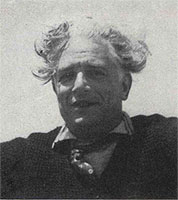
 Michel Dufet was born in Deville-les-Rouen on December 8, 1888. He was a former student of the École Supérieure des Beaux-Arts for architecture and painting, and he was a member of the Order of Architects. In 1913, he founded the Society M.A.M. where he presented furniture models.
Michel Dufet was born in Deville-les-Rouen on December 8, 1888. He was a former student of the École Supérieure des Beaux-Arts for architecture and painting, and he was a member of the Order of Architects. In 1913, he founded the Society M.A.M. where he presented furniture models.
Since 1919, he exhibited at the Salon d'Automne and the Salon des Artistes Décorateurs, of which he became a member from the start. At the Salon d'Automne in 1926, he presented a significant collection of Cubist-inspired furniture. He also participated in the 1931 Colonial Exhibition with the offices of Marshal Lyautey and the Commissioner General. In the 1937 International Exhibition, he co-organized the wallpaper class with René Gabriel, and in 1938, he was appointed as the architect for the French Participation at the New York World's Fair.
He designed private installations for numerous Parisian personalities. He had a particular interest in boats and arranged the children's playroom for the first "lie de France" and went on to create large luxury ensembles for the "Foch," the "Normandie," the "Ile de France," and specialized in the architecture and interior decoration of private yachts. From 1924 to 1939, he directed the Art Gallery du Bûcheron (luxury and series furniture) in collaboration with Léandre Vaillat. In 1918, he created "Feuillets d'art," and in 1923, he was called to Rio to lead "Red Star" to establish a modern decorative art movement. Since then, he has contributed to the foundation or editing of newspapers and periodicals; he has been the editor-in-chief of the magazine "Décor d'Aujourd'hui" since 1933.
Since 1928, Bourdelle had entrusted him with establishing plans for the museum he wanted to build at Place d'Iéna. He participated in the organization of the current Musée Bourdelle and has dedicated himself since then, through exhibitions and conferences in Paris, the provinces, and abroad, to promoting the Master's work. Michel Dufet, a Knight of the Legion of Honour since 1936, was promoted to Officer in 1952. Michel Dufet's activities are diverse and varied; while in recent years, he has devoted much of his time to Bourdelle's work, he continues to advocate for modern art through articles and lectures. Throughout his career, he worked on developing a "style of today," considering both the requirements of contemporary life, aesthetic evolution, and contributions from machinery.
While his taste and significant commissions led him to conceive refined and luxurious ensembles, using a variety of materials (including offices with harmonious volumes made entirely of zinc), his scientific curiosity and imagination led him into clever mechanical adaptations.
For instance, he created the bedroom and working cabinet of the former director of Comoedia, Mr. Rovera, where furniture, objects, lighting, and heating could transform, emerge, intensify, or neutralize with the click of a button on a large control panel.
This spectacular and occasional application was aligned with very specific concerns - "the tele-mechanization of human equipment," a logical extension of serial furniture. According to Michel Dufet, this latter problem was the key and could only be solved through industrial manufacturing similar to the practices in America for car frames. He envisioned the execution of interchangeable elements that could, through a happy balance of proportions and judicious use of new materials, lend themselves to multiple combinations, eliminating uniformity. The artist's ingenuity, taste, and scientific knowledge must, in Michel Dufet's view, collaborate in the rational organization of living spaces. In this way, decorative art would fulfill its dual mission of aesthetics and social relevance.
SOURCES : MOBILIER ET DECORATION N° 4 MAI 1954